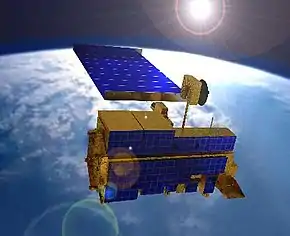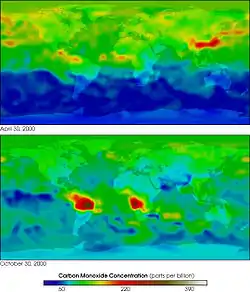Measurements of pollution in the stratosphere
MOPITT (pour Measurements of Pollution in the Troposphere / Mesures de la pollution troposphérique) est un radiomètre travaillant dans l'infrarouge installé sur le satellite Terra (1999) et destiné à améliorer la connaissance de la dynamique de certains polluants (monoxyde de carbone, Méthane[1]) de la basse et moyenne atmosphère (troposphère), émis à partir du sol (véhicules, chaudières, feux...), à partir des mers (navires) ou par des sources mobiles aéroportées telles que les avions. C'est aussi le nom du programme de mesure correspondant, porté par la NASA.

L'instrument a été financé par la Division des sciences spatiales de l'Agence spatiale canadienne.


Utilité, objectifs
Cet instrumentation est conçue pour surveiller les changements dans les patterns (motifs) de pollution pour la partie inférieure de l'atmosphère terrestre afin de mieux comprendre l'évolution et le cycle des polluants et certaines interactions entre polluants ou entre polluants et climat. Les instruments ont été qualibrés[6] et vérifiés au moyen d'intercomparaisons[7] faites avec d'autres instruments et par des mesures faites à partir d'air échantillonnés par des avions en vol[8].
Bien que les observations des teneurs en méthane (puissant gaz à effet de serre, en augmentation) aient été également annoncées, à ce jour aucune donnée relative au CH4 n'a été publiée.
Instrument
MOPITT est un outil de sondage au nadir (verticale pointant vers le bas) qui mesure l'upwelling infrarouge (le rayonnement infrarouge réfléchi) à 4,7 µm et 2,2 à 2,4 µm.
Il utilise la corrélation spectroscopique pour calculer des profils de monoxyde de carbone dans la basse atmosphère.
Voir aussi
Articles connexes
- Atmosphère
- Troposphère
- Pollution atmosphérique
- Terra (satellite)
- Réchauffement climatique
- Gaz à effet de serre
- Ozone
- Contrails (trainées de condensation de réacteurs d'avion)
Liens externes
- (en) Portail officiel du projet MOPITT (science and product development team)
- (en) Les missions de Mopitt ; avec archives
- (en) Présentation du programme MOPITT par l'université de Toronto
- (en) « Archives Nasa »(Archive.org • Wikiwix • Archive.is • Google • Que faire ?) (consulté le )
- (en) Données MOPITT accessible via NASA-Langley
- (en) NASA Terra site
- (en) Fiche de Terra 1 sur le catalogue du National Space Science Data Center
Bibliographie
- (en) Drummond JR, Mand GS, « The measurements of pollution in the troposphere (MOPITT) instrument: Overall performance and calibration requirements », Journal of Atmospheric and Oceanic Technology, vol. 13, no 2, , p. 314–320 (ISSN 1520-0426, DOI 10.1175/1520-0426(1996)013<0314:TMOPIT>2.0.CO;2, Bibcode 1996JAtOT..13..314D)
- (en) Bowman KP, « Transport of carbon monoxide from the tropics to the extratropics », Journal of Geophysical Research-Atmosphere, vol. 111, , p. D02107 (DOI 10.1029/2005JD006137, Bibcode 2006JGRD..11102107B)
- L. K. Emmons & al. « Validation of Measurements of Pollution in the Troposphere (MOPITT) CO retrievals with aircraft in situ profiles »(Archive.org • Wikiwix • Archive.is • Google • Que faire ?) (consulté le ) ; JOURNAL OF GEOPHYSICAL RESEARCH, VOL. 109, D03309, doi:10.1029/2003JD004101, 2004, 17 pages
- Warner, J., J. Gille, D. P. Edwards, D. Ziskin, M. Smith, P. Bailey, and L. Rokke (2001), Cloud detection and clearing for the earth observing
system Terra satellite Measurements of Pollution in the Troposphere (MOPITT) experiment, Appl. Opt., 40, 1269– 1284.
Références
- (en) Cet article est partiellement ou en totalité issu de l’article de Wikipédia en anglais intitulé « MOPITT » (voir la liste des auteurs).
- James R. Drummond, "Measurements of pollution in the troposphere (MOPITT) instrument", Proc. SPIE 1939, 126 (1993); doi:10.1117/12.152839 (Résumé)
- Novelli, P. C., K. A. Masarie, P. M. Lang, B. D. Hall, R. C. Myers, and J.W. Elkins (2003), Re-analysis of tropospheric CO trends: Effects of the 1997– 1998 wildfires, J. Geophys. Res., 108(D15), 4464, doi:10.1029/ 2002JD003031
- Jacob, D., et al. (2003), The Transport and Chemical Evolution over thePacific (TRACE-P) aircraft mission: Design, execution, and first results, J. Geophys. Res., 108(D20), 8781, doi:10.1029/2002JD003276.
- Novelli, P. C., K. A. Masarie, and P. M. Lang (1998), Distributions andrecent changes in carbon monoxide in the lower troposphere, J. Geophys.Res., 103, 19,015– 19,033.
- Swap, R. J., H. J. Annegarn, J. T. Suttles, M. D. King, S. Platnick, J. L. Privette, and R. J. Scholes (2003), Africa burning: A thematic analysis of the Southern African Regional Science Initiative (SAFARI 2000), J. Geophys. Res., 108(D13), 8465, doi:10.1029/2003JD003747.
- Drummond, J. R., and G. S. Mand (1996), The Measurements of Pollution in the Troposphere (MOPITT) instrument: Overall performance and calibration requirements, J. Atmos. Ocean. Technol., 13, 314– 320.
- Rodgers, C. D., and B. J. Connor (2003), Intercomparison of remote sounding instruments, J. Geophys. Res., 108(D3), 4116, doi:10.1029/ 2002JD002299
- Baehr, J., H. Schlager, H. Ziereis, P. Stock, P. van Velthoven, R. Busen, J. Stro¨m, and U. Schumann (2003), Aircraft observations of NO, NOy, CO and O3 in the upper troposphere from 60°N to 60°S—Interhemispheric differences at midlatitudes, Geophys. Res. Lett., 30(11), 1598, doi:10.1029/2003GL016935